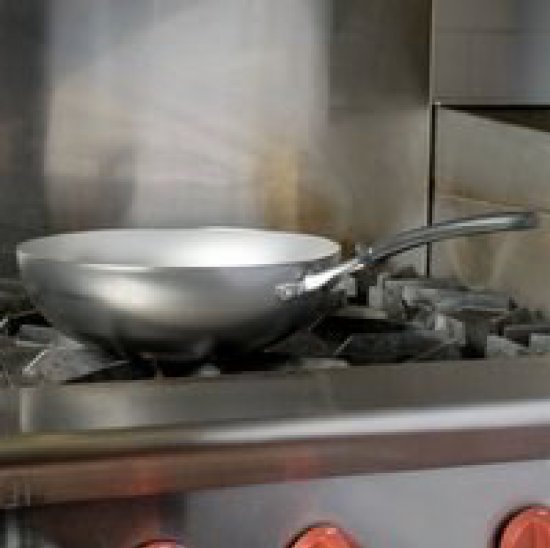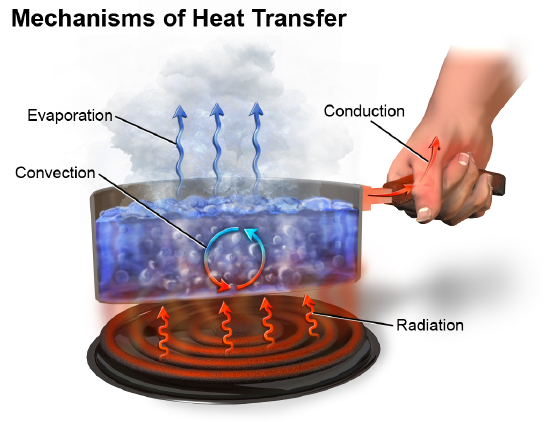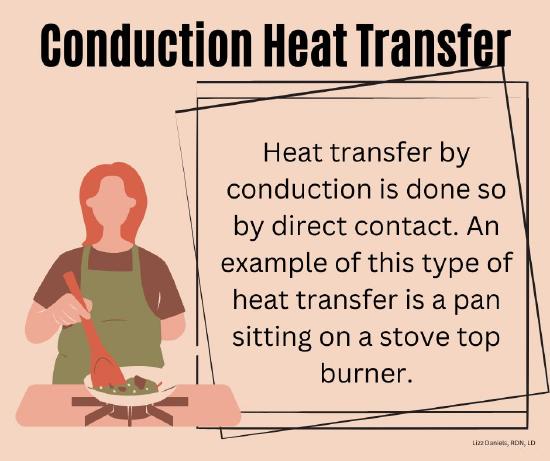1.2.5: Understanding Heat
- Page ID
- 64421
\( \newcommand{\vecs}[1]{\overset { \scriptstyle \rightharpoonup} {\mathbf{#1}} } \)
\( \newcommand{\vecd}[1]{\overset{-\!-\!\rightharpoonup}{\vphantom{a}\smash {#1}}} \)
\( \newcommand{\id}{\mathrm{id}}\) \( \newcommand{\Span}{\mathrm{span}}\)
( \newcommand{\kernel}{\mathrm{null}\,}\) \( \newcommand{\range}{\mathrm{range}\,}\)
\( \newcommand{\RealPart}{\mathrm{Re}}\) \( \newcommand{\ImaginaryPart}{\mathrm{Im}}\)
\( \newcommand{\Argument}{\mathrm{Arg}}\) \( \newcommand{\norm}[1]{\| #1 \|}\)
\( \newcommand{\inner}[2]{\langle #1, #2 \rangle}\)
\( \newcommand{\Span}{\mathrm{span}}\)
\( \newcommand{\id}{\mathrm{id}}\)
\( \newcommand{\Span}{\mathrm{span}}\)
\( \newcommand{\kernel}{\mathrm{null}\,}\)
\( \newcommand{\range}{\mathrm{range}\,}\)
\( \newcommand{\RealPart}{\mathrm{Re}}\)
\( \newcommand{\ImaginaryPart}{\mathrm{Im}}\)
\( \newcommand{\Argument}{\mathrm{Arg}}\)
\( \newcommand{\norm}[1]{\| #1 \|}\)
\( \newcommand{\inner}[2]{\langle #1, #2 \rangle}\)
\( \newcommand{\Span}{\mathrm{span}}\) \( \newcommand{\AA}{\unicode[.8,0]{x212B}}\)
\( \newcommand{\vectorA}[1]{\vec{#1}} % arrow\)
\( \newcommand{\vectorAt}[1]{\vec{\text{#1}}} % arrow\)
\( \newcommand{\vectorB}[1]{\overset { \scriptstyle \rightharpoonup} {\mathbf{#1}} } \)
\( \newcommand{\vectorC}[1]{\textbf{#1}} \)
\( \newcommand{\vectorD}[1]{\overrightarrow{#1}} \)
\( \newcommand{\vectorDt}[1]{\overrightarrow{\text{#1}}} \)
\( \newcommand{\vectE}[1]{\overset{-\!-\!\rightharpoonup}{\vphantom{a}\smash{\mathbf {#1}}}} \)
\( \newcommand{\vecs}[1]{\overset { \scriptstyle \rightharpoonup} {\mathbf{#1}} } \)
\( \newcommand{\vecd}[1]{\overset{-\!-\!\rightharpoonup}{\vphantom{a}\smash {#1}}} \)
\(\newcommand{\avec}{\mathbf a}\) \(\newcommand{\bvec}{\mathbf b}\) \(\newcommand{\cvec}{\mathbf c}\) \(\newcommand{\dvec}{\mathbf d}\) \(\newcommand{\dtil}{\widetilde{\mathbf d}}\) \(\newcommand{\evec}{\mathbf e}\) \(\newcommand{\fvec}{\mathbf f}\) \(\newcommand{\nvec}{\mathbf n}\) \(\newcommand{\pvec}{\mathbf p}\) \(\newcommand{\qvec}{\mathbf q}\) \(\newcommand{\svec}{\mathbf s}\) \(\newcommand{\tvec}{\mathbf t}\) \(\newcommand{\uvec}{\mathbf u}\) \(\newcommand{\vvec}{\mathbf v}\) \(\newcommand{\wvec}{\mathbf w}\) \(\newcommand{\xvec}{\mathbf x}\) \(\newcommand{\yvec}{\mathbf y}\) \(\newcommand{\zvec}{\mathbf z}\) \(\newcommand{\rvec}{\mathbf r}\) \(\newcommand{\mvec}{\mathbf m}\) \(\newcommand{\zerovec}{\mathbf 0}\) \(\newcommand{\onevec}{\mathbf 1}\) \(\newcommand{\real}{\mathbb R}\) \(\newcommand{\twovec}[2]{\left[\begin{array}{r}#1 \\ #2 \end{array}\right]}\) \(\newcommand{\ctwovec}[2]{\left[\begin{array}{c}#1 \\ #2 \end{array}\right]}\) \(\newcommand{\threevec}[3]{\left[\begin{array}{r}#1 \\ #2 \\ #3 \end{array}\right]}\) \(\newcommand{\cthreevec}[3]{\left[\begin{array}{c}#1 \\ #2 \\ #3 \end{array}\right]}\) \(\newcommand{\fourvec}[4]{\left[\begin{array}{r}#1 \\ #2 \\ #3 \\ #4 \end{array}\right]}\) \(\newcommand{\cfourvec}[4]{\left[\begin{array}{c}#1 \\ #2 \\ #3 \\ #4 \end{array}\right]}\) \(\newcommand{\fivevec}[5]{\left[\begin{array}{r}#1 \\ #2 \\ #3 \\ #4 \\ #5 \\ \end{array}\right]}\) \(\newcommand{\cfivevec}[5]{\left[\begin{array}{c}#1 \\ #2 \\ #3 \\ #4 \\ #5 \\ \end{array}\right]}\) \(\newcommand{\mattwo}[4]{\left[\begin{array}{rr}#1 \amp #2 \\ #3 \amp #4 \\ \end{array}\right]}\) \(\newcommand{\laspan}[1]{\text{Span}\{#1\}}\) \(\newcommand{\bcal}{\cal B}\) \(\newcommand{\ccal}{\cal C}\) \(\newcommand{\scal}{\cal S}\) \(\newcommand{\wcal}{\cal W}\) \(\newcommand{\ecal}{\cal E}\) \(\newcommand{\coords}[2]{\left\{#1\right\}_{#2}}\) \(\newcommand{\gray}[1]{\color{gray}{#1}}\) \(\newcommand{\lgray}[1]{\color{lightgray}{#1}}\) \(\newcommand{\rank}{\operatorname{rank}}\) \(\newcommand{\row}{\text{Row}}\) \(\newcommand{\col}{\text{Col}}\) \(\renewcommand{\row}{\text{Row}}\) \(\newcommand{\nul}{\text{Nul}}\) \(\newcommand{\var}{\text{Var}}\) \(\newcommand{\corr}{\text{corr}}\) \(\newcommand{\len}[1]{\left|#1\right|}\) \(\newcommand{\bbar}{\overline{\bvec}}\) \(\newcommand{\bhat}{\widehat{\bvec}}\) \(\newcommand{\bperp}{\bvec^\perp}\) \(\newcommand{\xhat}{\widehat{\xvec}}\) \(\newcommand{\vhat}{\widehat{\vvec}}\) \(\newcommand{\uhat}{\widehat{\uvec}}\) \(\newcommand{\what}{\widehat{\wvec}}\) \(\newcommand{\Sighat}{\widehat{\Sigma}}\) \(\newcommand{\lt}{<}\) \(\newcommand{\gt}{>}\) \(\newcommand{\amp}{&}\) \(\definecolor{fillinmathshade}{gray}{0.9}\)
The Relationship between Heat Transfer and Cooking
Have you ever wondered what is actually happening when you are cooking food? While this is something that we usually take for granted, this process of heating food - known as heat transfer - is complicated and fascinating. Keep reading to learn more about the relationship between heat transfer and cooking and the important role it plays in your kitchen.

Heating Foods
Since fire was first discovered, humans have been heating their foods. One of the coolest things about that is that the process and ability of heating and cooking foods is believed to be one of the reasons that we, as humans, have evolved with larger brains! Cooking foods has also helped keep humans healthy by killing harmful pathogens that cause foodborne illness.
Heat can help break down tough starchy vegetables so that they are not only easier to chew but easier to digest with an increased bioavailability of their nutrients. Muscle fibers of animal proteins are denatured by heat and therefore easier to chew and much more palatable. Furthermore, by cooking certain vegetables such as onions and garlic we can manipulate their flavors from strong and pungeont to sweet and savory.
What is Heat Transfer?
Heat transfer is an exchange of thermal energy between two objects. The rate of heat transfer depends upon the temperatures of each entity and the medium through which the thermal energy is being transferred. In cooking, heat transfer often refers to heating your food items through a cooking appliance, such as a stove, fryer, microwave, or oven but can also apply to cooking over an open fire or barbeque grill.
How is Heat Transfer Used in Cooking?
Heat transfer is a very important aspect of the cooking process. Heating food destroys potentially harmful bacteria and other microorganisms, which makes food safe to eat and easier to digest. When food or liquids become hot, their molecules absorb energy, begin vibrating rapidly, and start to bounce off of each other. As they collide, heat energy is produced and transferred, which warms and cooks the food.
Methods of Heat Transfer
There are 3 main types of heat transfer:
- Conduction
- Convection
- Radiation
Each of these methods features its own unique characteristics, but there is also some crossover between the different types.

BruceBlaus, CC BY-SA 4.0, via Wikimedia Commons
What is Conduction?
Conduction is the process of heat being transferred between objects through direct contact, and it's the most common type of heat transfer. For example, in cooking the burners on stoves will conduct heat energy to the bottom of a pan sitting on top of it. From there, the pan conducts heat to its contents.
A deep fryer also uses conduction heating as the hot oil cooks the food when it comes into direct contact with it. Additionally, conduction heat is responsible for moving heat from the outside of the food to the inside. As a result, conduction heat also happens when cooking with convection and radiation heating methods.
Conduction is the slowest method of heat transfer, but the direct contact between the cooking surface and the item to be heated allows food to be cooked from the outside in. When cooking a steak in a cast iron skillet, for example, conduction produces an evenly cooked exterior and a moist, juicy interior that guests are sure to love.

Examples of Conduction Cooking
Here are a few examples conduction heat transfer:
- Burning your hand on a hot burner.
- Grilling meat on a grill.
What is Convection?
Convection heat transfer can be either natural or forced and is often dependent on the physical forces that exist between particles of different temperatures. What is used most often in cooking is forced convection (usually in an oven) which circulates warm air around the food for quicker cooking.
.jpg?revision=1&size=bestfit&width=297&height=249)
Natural Convection
Natural convection occurs when molecules at the bottom of a cooking vessel rise and warm while cooler and heavier molecules sink. This creates a circulating current that evenly distributes heat throughout the substance being prepared.
For example, when a pot of water is placed on the stove to boil, conduction heat warms up the pot, which then heats the water molecules inside. As these molecules heat, convection causes them to move away from the interior of the pot as they are replaced by cooler molecules. This continuous current creates convection heat transfer within the water.
Mechanical Convection
Mechanical convection occurs when outside forces circulate heat, which shortens cooking times and cooks food more evenly. Examples of this include stirring liquid in a pot or when a convection oven uses a fan and exhaust system to blow hot air over and around the food before venting it back out.
Examples of Convection Cooking
Here are a few examples of how heat transfer via convection works:
A boiling pot of water.
A piece of food inside of an air fryer.
What is Radiation Cooking?
In cooking, radiation is the process where heat is transferred without any direct contact with the heat source. There are two common types of radiation heat transfer cooking methods:
Infrared Radiation
While other types of heat transfer rely on the movement of particles, infrared uses electromagnetic waves to heat food. Improvements in technology have led to the invention of infrared cooking grills and cook tops which use specific materials to limit convection cooking while maximizing infrared cooking potential.
Microwave Radiation
Microwave radiation works by agitating molecules within the food that is being cooked. Microwaves do not cook food from the inside out despite this being a common thought. Instead, microwaves are able to penetrate the food being cooked about 1" where they excite particles in the food which can heat the inner layers through conduction. Liquids cooked inside of the microwave may be initially excited by the electromagnetic waves but then proceed to heat through convection as the liquid moves around in the cooking container. Oftentimes, there is more than one heat transfer method occurring at once
Whether you are using a pan on a stove, a convection oven, or a heavy-duty microwave, conduction, convection, and radiation are all around us. Knowing and understanding what heat transfer is, how it works, and which type of heat transfer is happening as you cook can help you better understand the science of cooking and improve your skills as a chef.
.jpg?revision=1&size=bestfit&width=374&height=314)
.jpg?revision=1&size=bestfit&width=374&height=314)
References:
Understanding Food Principles and Preparation by Amy Brown
Kitchen Wise Essential Food Science for Home Cooks by Shirley O. Corriher


